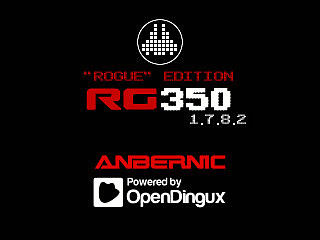Thanks to Tonyjin for toolchain (https://github.com/tonyjih) Special Thanks to Pcercuei (https://github.com/pcercuei), Mthuurne (https://github.com/mthuurne) and opendingux (https://github.com/OpenDingux) for the original code base system.
- exFAT support, auto-resize, constant sdcard mount point, show version - 1.7.5 branch
- Add Esoteric how optional launcher - 1.7.9 branch
- Suspend capability - 1.8.x branch
- Kernel update -2.x branch
- Modernize 3D APIs - 2.1.x
- HDMI support - 2.2.x
- Vulkan?? - Future
https://github.com/Ninoh-FOX/OpenRGH/releases/tag/1.7.9
https://github.com/Ninoh-FOX/OpenRGH/releases/tag/1.7.8.2
https://github.com/Ninoh-FOX/OpenRGH/releases/tag/1.7.8.1
https://github.com/Ninoh-FOX/OpenRGH/releases/tag/1.7.8
https://drive.google.com/file/d/13iNEBQlbFkueCSAsnWpv8cVGKJv8ihpX/view
https://drive.google.com/file/d/1kMVWTWTym6TfN3_nrM9N2QSFf2dUxxjp/view
- Change boot logo (again), OpenDingux logo removed for respect to the original creator of the system.

- All references to OpenDingux removed, except in the system information as thanks for the original base system.
- Gmenu2x now read and write all from home.
- Esoteric add how optional launcher in the system. (Thanks to Podulator https://github.com/podulator/esoteric).
- Update RG350Tests in sd_imagen (thanks to https://github.com/RafaVico).
- Now sd_imagen too in opk file, you can now reflash the sdcard without open the console (this erase all).
- Now work updates and flashers opks in another launchers.
- boot partition now is mount too in /media/system in rw mode for recovery the system from pc if this is possible.
- Gmenu2x now can link .opk and .dge files.
- New boot logo.
- New flasher sdcatd imagen (thanks to https://github.com/gcwnow/imager )
- lazy_itable_init = 0 and lazy_journal_init = 0 support added to EXT4 file system.
- Display version in System Info app.
- exfAT support added - no more need to download a utility to format 64GB+ SD cards
- Default SD card mount changed to /media/sdcard - No having to re-do paths when swapping SD cards
- Auto swap file and partition resize - This takes a while, allow it to finish. Progress will be shown on screen during first boot
- Duplicate modules removed from modules.squashfs
- Fix the resize in old stock firmwares (bad ext4 partition)
- Fixed power off and reboot error messages
- Fixed slowdowns and stuttering during first 15 minutes after first boot )8. Rebuild mininit-syspart from original opendingux code. (Thanks to https://github.com/OpenDingux/mininit)
- Autoremove old configs of the system in the first boot.
- Change file system table.
- Restore USB-HID suport.
- update libshake from original code: https://github.com/zear/libShake
NOTE: If is your first install time for this cfw, the optimus is user sd_image.bin, afte, you can use alway the opks files for update. sd_image.bin erase all data in sdcard!! If you gone from another CFW is better that you make a backup of the folders local/home and local/app first.
- Place the update opk file in /media/data/apps or /media/sdcard/apps.
- Run from your prefer launcher.
- allow process to complete.
- Reboot.
- If system fails to boot, press Y to boot to last working kernel, or X to boot to last working rootfs. X+Y will load your previous OS version.
- Place the flasher opk file in /media/data/apps or /media/sdcard/apps.
- Run from your prefer launcher.
- allow process to complete.
- Reboot.
- Download a base system "sd_image.bin" from releases.
- Format the new sdcard / internel sdcard with SD FORMATTER 5.0.1 ( https://www.sdcard.org/downloads/formatter/ ) two times.
- Download Win32 disk imager ( https://sourceforge.net/projects/win32diskimager/ ) and flash (writer) the FW base imagen in the sdcard.
4. NOT RESIZER THE EXT4 PARTITION IN WINDOWS!!
only put the internal sd in the console and follow the instructions.
-
Format the new sdcard / internel sdcard with gnome-disk-utility.
-
Flash the FW base imagen in the sdcard with gnome-disk-utility. Or type in a terminal:
sudo dd if=sd_image.bin of=/dev/[sdcard mount point]
thanks to https://github.com/gcwnow wiki
This work for GMENUNX.
You can copy the kernel or rootfs to the internal SD card of the RG350 using FTP, SFTP or SCP. I recommend SCP since it is just one line on the command prompt. It does require setting up SSH keypair authentication though.
for kernel
scp vmlinuz.bin [email protected]:/media/system/
scp modules.squashfs [email protected]:/media/system/update_m.bin
for rootfs
scp rootfs.squashfs [email protected]:/media/system/update_r.bin
Reboot the RG350 to activate the new kernel or rootfs. Don't use the reset button: part of the kernel or of the rootfs may not have been flushed from the write cache yet.
You can use:
ssh [email protected] RG350:media/data/local/home# reboot
Una bifurcación independiente del proyecto OpenDingux, enfocada en mejorar la experiencia del usuario.
Gracias a Tonyjih por el toolchain (https://github.com/tonyjih) Agradecimiento especial para Pcercuei (https://github.com/pcercuei), Mthuurne (https://github.com/mthuurne) y opendingux (https://github.com/OpenDingux) por el codigo del sistema base.
- Soporte exFAT, auto-redimensionado, sdcard es montada siempre como sdcard, muestra de la version - 1.7.5 branch
- Agregar Esotérico como lanzador opcional - 1.7.9 branch
- Función de suspención real - 1.8.0 brach
- actualizacion del kernel -2.x branch
- actualizar 3D APIs - 2.1.x
- soporte HDMI - 2.2.x
- Vulkan?? - Future
https://github.com/Ninoh-FOX/OpenRGH/releases/tag/1.7.9
https://github.com/Ninoh-FOX/OpenRGH/releases/tag/1.7.8.2
https://github.com/Ninoh-FOX/OpenRGH/releases/tag/1.7.8.1
https://github.com/Ninoh-FOX/OpenRGH/releases/tag/1.7.8
https://drive.google.com/file/d/13iNEBQlbFkueCSAsnWpv8cVGKJv8ihpX/view
https://drive.google.com/file/d/1kMVWTWTym6TfN3_nrM9N2QSFf2dUxxjp/view
- Cambie el logotipo de arranque (de nuevo), elimine el logotipo de OpenDingux por respeto al creador original del sistema.

- Se eliminaron todas las referencias a OpenDingux, excepto en la información del sistema como agradecimiento por el sistema base original.
- Gmenu2x ahora lee y escribe todo desde HOME.
- Esoteric añadido cómo lanzador opcional en el sistema. (gracias a Podulator https://github.com/podulator/esoteric).
- Actualización de RG350test en sd_imagen (gracias a https://github.com/RafaVico).
- Ahora sd_imagen también en archivo opk, ahora puede actualizar la tarjeta sd sin abrir la consola (esto borra todo).
- Ahora funcionan las opks de actualizaciones y flashes en otros lanzadores.
- Cambio del logo de carga.

- Nuevo nombre del firmware.
- Actualizada algunas librerias.
- Gmenu2x ahora es linkeado en /local/home/.gmenu2x
- la particion boot ahora es tambien montada en /media/system en modo escritura, para poder recuperar la consola sin abrirla en caso de fallo dentro de lo posible.
- Gmenu2x ahora puede enlazar archivos .opk y .dge.
- Nuevo logo de carga.
- Nueva imagen de la tarjeta MicroSD (Gracias a https://github.com/gcwnow/imager )
- lazy_itable_init = 0 and lazy_journal_init = 0 se ha añadido al sistema de archivo del sistema ext4.
- Se muestra la version del sistema en System Info app.
- exFAT añadido - ya no es necesario decargar herramientas para formatear en FAT32 microsd de 64GB+.
- El directorio por defecto para la microsd es ahora /media/sdcard - ya no habra problemas con microsds con diferentes etiquetas.
- Modo automatico de expansion del las particiones de la sdcard y creacion de la memoria swap - esto puede tardar un poco, pero esta preparado para que solo suceda en el primer arranque tras actualizar si es necesario.
- Borrado modulos duplicados de modules.squashfs
- Corregido la expansion de particiones en stock firmwares viejos (las imagenes sd tienen mal el sistema ext4)
- Corregido mensajes de error al apagar o reiniciar
- Corregido relentizaciones que se producian tras los primeros 15min de que la consola estuviera encendida.
- Rehecho mininit-syspart desde el codigo original de opendingux (Gracias a https://github.com/OpenDingux/mininit)
- Removidas configuraciones residuales en el primer arranque.
- Cambiada el sistema de particiones.
- Resturado el soporto USB-HID (OTG).
- Actualizado libshake desde el codigo original: https://github.com/zear/libShake
Nota: Si es la primera vez que actualizas este firmware, lo idoneo es que uses el archivo sd_image.bin, luego ya despues puedes seguir actualizando por opk. Impotante, sd_image.bin borra toda la sd, por lo que primero, y si vienes de otro FW tambien, es mejor que hagas copias de las carpetas /local/home y /local/apps antes de actualizar.
- Coloca el update en OPK /media/data/apps o /media/sdcard/apps
- Arranca OS Update desde Gmenu2x (actualmente no funciona en Gmenunx)
- Espera a que el proceso termine.
- Reinicia
- Si ves que el sistema falla al reiniciar, presiona Y para cargar el ultimo kernel que funcionó, o X para cargar el ultimo sistema de archivos que funcionó. X+Y para cargar la ultima version del sistema que funcionó. Esto es una carga temporar, pero te servirá para volver a intentarlo o para probar otro metodo de actualización.
- Coloca el flasher en OPK en /media/data/apps o /media/sdcard/apps
- Arranca Flasher desde el launcher que prefieras.
- Espera a que el proceso termine.
- Reinicia
- Descarga el sistema base "sd_image.bin" del release.
- Formatea la microsd interna o nueva con SD FORMATTER 5.0.1 ( https://www.sdcard.org/downloads/formatter/ ) dos veces.
- Descarga Win32 disk imager ( https://sourceforge.net/projects/win32diskimager/ ) y flashea (escribir) la imagen del cfw (sd_image.bin) en la microsd.
4. NO EXTIENDAS LA PARTICION EXT4 EN WINDOWS!!
solo pon la microsd dentro de la consola, enciendela y sigue las instrucciones.
-
Formatea la microsd interna o nueva con gnome-disk-utility. (da igual el formato)
-
flashea la microsd (reescribir imagen de disco) con gnome-disk-utility. O escribe en el terminal:
sudo dd if=sd_image.bin of=/dev/[punto de montaje de la microsd]
4. NO EXTIENDAS LA EXTENSION!! solo pon la microsd dentro de la consola, enciendela y sigue las instrucciones.
Gracias al wiki de https://github.com/gcwnow
Este metodo funciona tambien en GMENUNX.
Puede copiar el kernel o rootfs a la tarjeta SD interna del RG350 usando FTP, SFTP o SCP. Recomiendo SCP ya que es solo una línea en el símbolo del sistema. Sin embargo, requiere configurar la autenticación de par de claves SSH.
para el kernel
scp vmlinuz.bin [email protected]:/media/system/
scp modules.squashfs [email protected]:/media/system/update_m.bin
para rootfs
scp rootfs.squashfs [email protected]:/media/system/update_r.bin
Reinicie el RG350 para activar el nuevo kernel o rootfs. No use el botón de reinicio: parte del kernel o de los rootfs pueden no haberse eliminado aún de la caché de escritura.
Puedes usar el comando reboot:
ssh [email protected] RG350:media/data/local/home# reboot

